|
Many years ago, back when I was in my first year at film school, a student in the year above me who became my closest friend was at the time already getting a bit of a reputation for the films he chose to make. He never took what you might call the safe or obvious route and did tend to delight in kicking against the film school norm with works that intermittently tinkered with the boundaries of taste. But these were well-made and often highly inventive films that were popular with a number of his fellow students, myself included. The head of the school was not so enraptured. He wasn't too worried what we did when we were working on self-funded 8mm or video projects, but once we moved on to school-funded 16mm, scripts had to be approved by him before they were permitted to go into production. That's where the creative censorship kicked in, as part of the criteria for approval was that the finished films could be shown to the public and the college governors without causing even a whiff of offence. We were thus discouraged from including any harsh language or violence, and full-frontal nudity was right out. Thus, when my friend presented the colourful but inventive script for his first 16mm project, the head of the school read through it, intermittently shaking his head in dismay, then asked my friend wearily, "Why can't you make a nice film?" to which he cheerily replied, "Oh, anyone can make a nice film. I want to make something interesting."
Gaspar Noé certainly doesn't make 'nice' films, but by thunder does he make interesting ones. Actually, interesting doesn't cut it. His films are confrontational, experimental, risk-taking and boundary-pushing. If he had gone to the film school I attended, he wouldn't have made to the end of the first term. His films directly challenge the viewer in both their content and their style, an approach typified by his second feature, Irrevérsible, a rape-revenge story whose reverse-running narrative turned every aspect of this often exploitative subgenre on its head. Its notorious, ten-minute, single-shot rape scene is almost impossible to watch (and was designed to be so), while the opening ultraviolent nightclub assault is made all the more tortuous by a stomach-churning use of wildly mobile camerawork and a soundtrack that includes the sort of anxiety-inducing, low frequency tone that the police sometimes employ to disperse crowds. Since then, Noé has taken us on a trippy out-of-body (and at one notorious point, in-body) experience in his 2009 Enter the Void, while his 2015 Love experimented with 3D and included scenes of unsimulated sex.
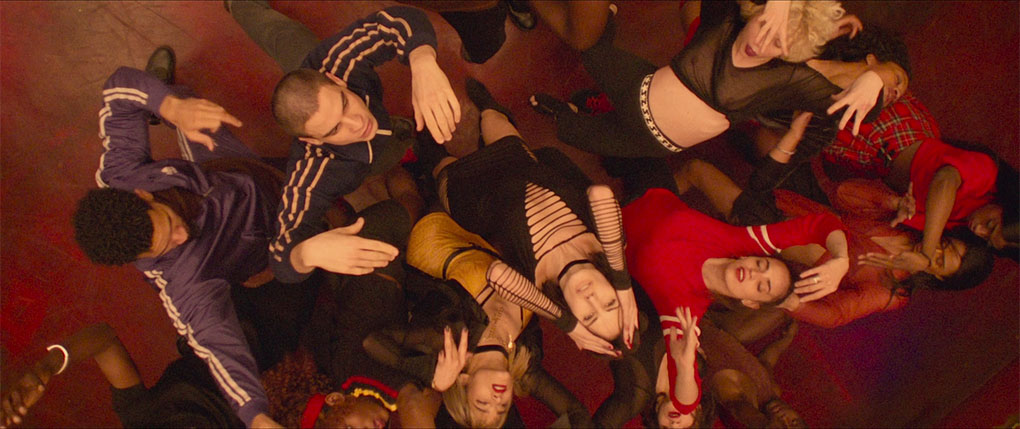
In what initially feels like a nod to Irréversible's reverse-narrative (but isn't), the teasingly titled Climax opens with its final shot and its end credits roll. We're then introduced to the film's characters via their in-film audition interviews, which subtly suggest the period setting by playing out on an old CRT TV, one flanked on one side by books and the other by VHS cassette tapes of movies. If you enjoy pinpointing influences on a film's style, structure, content and mise-en-scène, you'll have a field day here. I certainly did, though it's worth coming back to this after you've seen the film, by when you'll have an easier time spotting the various connections.
Then, following a series of production company logos and a signature Noé caption (large and in bold capitals) proclaiming that this is "a French film and proud of it," we are treated to what Noé regards as the opening sequence proper, and it's one the most exhilarating I've watched in some years. To the heart-pulsing beat of Cerrone's late 70s disco hit Supernature, the young people who featured in the audition tapes perform a dance routine for their manager Emmanuelle, one that they are planning to take on the road and perform in America. And it's amazing. This is modern dance at its most electrifyingly vibrant, a seamless blend of various styles that so astonished me that on its conclusion I jumped out of my seat and applauded. Providing an object lesson in how to film such a thrillingly choreographed and performed dance sequence, Noé and his regular cinematographer Benoît Debie capture the whole thing in a single shot, which pulls back to a static wide for its first half and only moves gracefully into top shot when the dance moves would be better showcased by this angular shift. The sequence emphatically establishes two things, that these are genuine dancers rather than actors doing dance steps, and that this multi-racial and cross-gender collection of individuals is able to work together as a unified group.
The shot doesn't end with the conclusion of this sequence (well, technically it does, but the join is invisible) and instead whip-pans over to the thrilled Emmanuelle, who has prepared a bowl of sangria for the dancers to drink as they party with each other for the rest of the evening. The setting is an abandoned school during the winter of 1996 and the group has just concluded three hard days of dance rehearsals, and as they each grab a drink and split off to socialise and dance for the sheer pleasure of doing so, the camera fluidly drifts between them like an unseen guest, circling gently around individuals as they interact with others before locking on someone else and following them to the next social encounter. This second sequence runs for eight seductive minutes as a single shot, and it's only when the dancers pair off to sit down and chat that the camera settles with them, switching to locked-down vignettes of various dancers in conversation.
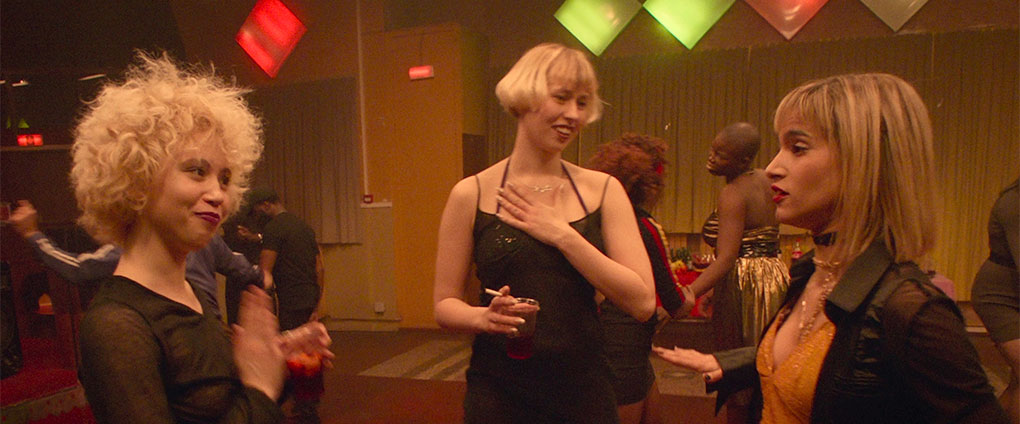
If the audition tapes told us something about the performers' backgrounds, passions and ambitions and the dance showcased their collective talent and strength as a group, here we get to know them a little as individuals and learn something about their relationships and sometimes surprising differences from each other. The most initially jarring of these is the skin-headed David, a dancer of considerable talent who is nonetheless contemptuous of gay relationships ("dyke stuff never works," he says of lesbian couple Psyche and Ivana, "they need cock") and appears to be on a quest to have sex with every woman in the company, irrespective of whether they are interested in him. Indeed, his repeated pestering of the independently minded Selva borders on aggressive harassment, and it's thus no surprise when of the female dancers describes him as "a ticket to an STD." Even sleazier but somewhat less aggressive about it are good friends Cyborg and Rocco, who giggle their way helplessly through a juvenile chat about the size of their respective dicks and what they would like to do with them, a conversation that you just know what dry up in an awkward heartbeat if a woman approached them. As we move around the dance floor we learn that the serious-minded Taylor is very protective of his sister Gazelle and is not happy that she's dating fellow dancer Omar, that the distracted Psyche appears to be losing interest in Ivana, that the solitary Alaia is addicted to cocaine, that the camp but virginal Riley has designs on the uninterested David, and that the downbeat Lou is not drinking because she feels unwell. And this is just a sampling. The conversations here were given a direction to follow by Noé but were otherwise left to the performers to improvise, and on the first viewing appear to be nothing more than snippets of engagingly naturalistic chat designed to introduce us to the characters with whom we will be spending the rest of the film. Watch the film a second time, however, and you become acutely aware just how much subtle foreshadowing there is in these dialogue exchanges, with what initially seem like offhand comments almost invisibly pointing us in the direction that the story and some of the character arcs will take. Also a key character here is Emmanuelle's young son Tito, who is popular with the dancers but who is tucked up in bed by his mother before the party downstairs really gets under way. His next appearance will prove a transformative one.
As the halfway point approaches we get a second dance sequence, as the exuberant company members circle round to watch each of them in turn attempt to out-perform the others in an improvised battle of dance. It's another electrifying display of talent, though this time is photographed exclusively from above, which has the effect of really focusing our attention on the dancers and not the figures that surround them. It's after this that everything changes, signified by the spectacularly late arrival of the main title credits and a close-up top shot of a cup being filled with sangria and carried across the hall. That something is wrong is visually signposted by a switch from the smoothly drifting camerawork of the first half to a more rough-and-ready handheld aesthetic, but the behaviour of some of the dancers goes beyond the effects of a few drinks: Psyche walks onto the dance floor and urinates where she stands, seemingly without even realising she's done so; Riley makes his promised move on the homophobic David, which he initially responds to; and an anxious Serva approaches the group's paternal DJ Daddy and desperately asks him what's going on, a question he's too distracted to usefully respond to. It soon becomes evident that someone has spiked the sangria with LSD and everyone who drank it is now suffering the effects, which vary from person to person depending on their personality, their constitution and how much they ingested. This revelation also sparks a wave of paranoia that engulfs the dancers, some of whom surrender to the drug's effects, while others experience mounting terror at the resulting disorientation and loss of control.
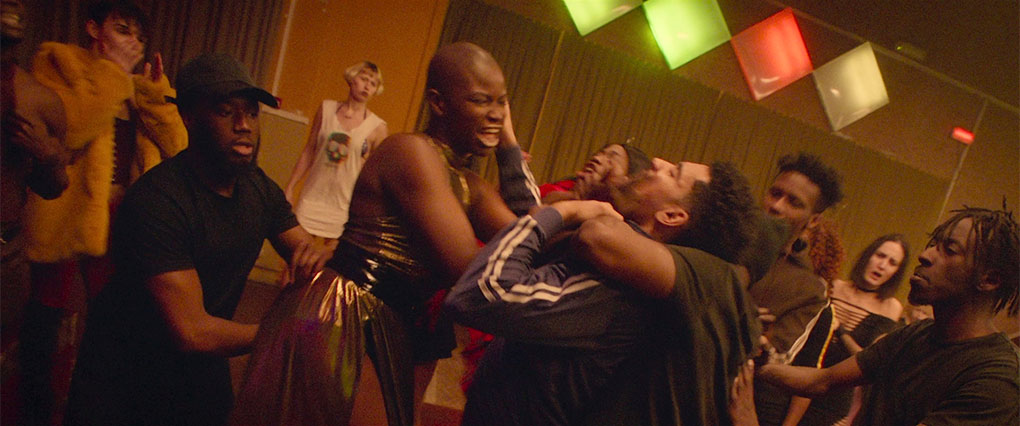
In the special features on this disc, Noé reveals that he has for some time wanted to make a film where a community goes crazy and has cited as a surprising influence the disaster movies of the 1970s, in which the audience was introduced to a large cast of characters, many of whom would be set to perish when catastrophe strikes. Here, the characters undergo a more complex process of drug-fuelled moral collapse and self-destruction, triggering a knee-jerk anger that three times sees the group blame the drugging of the sangria on the wrong person with increasingly destructive results. Inhibitions are abandoned and previously buried prejudices, anxieties and even desires are unleashed, and by the time a well-intentioned but poorly thought-out attempt to shield one character from harm takes a tragic turn, this microcosm of a diverse and previously civilised community has collapsed in on itself and stands on the brink of madness.
This descent into a metaphoric hell is visually mirrored by a power cut that bathes the dancers in the demonic red glow of the emergency lighting, and a camera that twists to discomforting angles and eventually flips over, giving the impression that gravity itself has abandoned the hall and the performers are dancing and writhing and freaking out on the ceiling. The music that provides a constant background beat also takes a more twisted turn here, blending with the shouts and desperate screams of the dancers and transforming the school building into a nightmarish series of rooms and corridors from which there seems no escape and which offer no safe haven. As the camera follows stoned individuals making their way to and from the dance hall, there are glimpses of personal horrors – one terrified girl trying to scrub blood off her naked body in a shower, another whose hair catches fire in a fight – that linger in the mind even after the camera has moved on. Occasionally, we get to witness the effects up front, as when one character (I'm avoiding names here to ease the spoiler factor) has an emotional breakdown so explosive that it almost becomes an improvised dance of madness, or when another is so heartlessly tormented by her drugged-up peers that she commits distressing acts of self-harm.
Yes, it's a tough ride, but it's also an artistically thrilling one. Given that there are only two professional actors in the cast, the performances are little short of extraordinary, with everyone committing completely to roles that they helped to create and unafraid to push the limits when the madness takes hold. As an audio-visual experience, the film is gripping, disturbing and ultimately frightening, as the drama evolves into a psychological horror that you don't just watch and listen to but experience as if you are caught in the maelstrom and being dragged down with it. It also boasts an absolute mother of a soundtrack constructed from past dance tracks of note, one that gets and fully deserves its own special feature on this very disc.
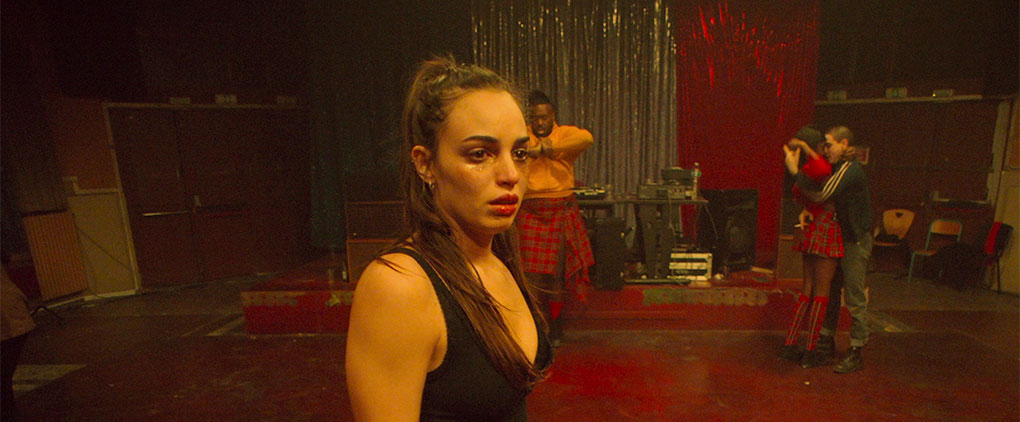
As is perhaps appropriate for the title, my first viewing of Climax left me breathless, shaken but deeply satisfied, but it was the second that revealed just how precisely and thoughtfully constructed a film this is, how almost every seemingly casual conversation and encounter in the vibrant first half also seems to signpost how events will unravel in the turbulent second. Some of Noé's cinematic influences are certainly visible but are so skilfully woven into the fabric of the film that he makes them his own, and the result is quite possibly his most accessible film to date, and for my money is one of his very best yet. It has also, I should note, put me off LSD for life.
An unsurprisingly clean and crisp 2.40:1 1080p transfer that captures the film's lively use of colour without over-saturation, even during the late film scenes where everyone is bathed in red light. The contrast is well balanced, and while the black levels are almost never solidly black, this look is consistent and appears to have been a choice made during the grading of the film itself, and certainly works for its chosen aesthetic.
The DTS-HD Master Audio 5.1 surround track is most impressively mixed and boasts an excellent dynamic range, although the LFE bass thump of the music is not quite as chest-rattling as I was expecting (if I re-route the bass from the music on the menu screen through the subwoofer it has noticeably more punch), but this also means that the soundtrack isn't a constant barrage of low frequency thumps. Frankly, the music sounds great here and the dialogue is always clearly mixed. The use of the surrounds is subtle but does provide a nicely inclusive audio experience.
Optional English subtitles for the deaf and hearing impaired are available.
Audio Commentary with Gaspar Noé
A seductively open and engaging commentary in which the soft-spoken Noé is pleasingly up-front about how sequences were prepared and shot and why decisions were made, and is emphatic that this was a collaborative effort, repeatedly emphasising how much the performers brought to their characters. He's happy to expose the tricks of his trade, identifying where invisible cuts were made to give the illusion of a continuous single shot, reveals that the smoothness of the camerawork in the first half was achieved by stabilising hand-held footage in post-production, and that the film was shot in an almost square aspect ratio and then cropped to 2.40:1, with the camera tilts and late-film switch to upside-down imagery all created in editing. He even points out a moment during one of the cast improvisations where he had to add a "weird sound effect" to drown out his apparently audible laughter. I was interested to learn how he was able to sync the dancing to the music and keep the dialogue clear, and there is plenty of information on the process of working with the performers and the logistics of shooting the film, as well as some analysis of the characters and their behaviour. I'm sure he echoes the thoughts of many a horror director when he states that the nice thing about setting the film in the 1990s is there are no smartphones. An excellent extra feature.
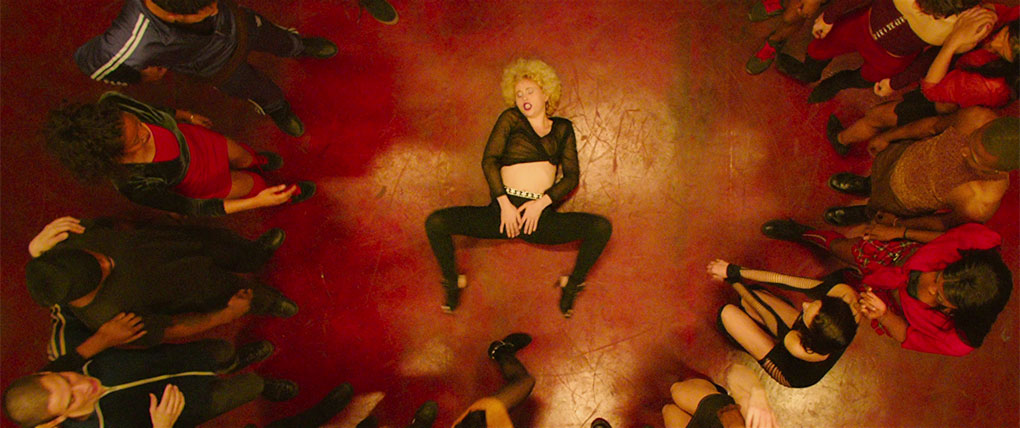
An Antidote to the Void (14:06)
A 2018 interview with Gaspar Noé that wittily sets the style for the other extras here by recreating the caption that heads up the opening dance scene but changing the text to "Not a French film and proud of it," and by interrupting the interview halfway with Noé-styled end credits. The director talks about wanting to make a film for some time where a community goes crazy, the influence of the disaster movies he enjoyed as a kid, the extensive use of improvisation in the film, giving the performers freedom to shape their own characters, the relevance of those movies whose video cassettes sit beside the audition footage, and more. He also tellingly reveals that a writer of his acquaintance praised the film for reviving the giallo subgenre, and hopes that the film will encourage people to dance.
Performing Climax(28:13)
Intercut interviews with cast members Kiddy Smile (who plays Daddy), Romain Guillermic (David) and Souheila Yacoub (Lou), who each reveal how they became involved in the project and talk about creating their own characters and improvising around a threadbare script. They also discuss the intense nightly shooting schedule, shooting and reshooting the longer single-shot sequences, the great on-set atmosphere and a good deal more. As the last person to join the cast and one of only two cast members from an acting background, Yacoub has some interesting recollections about initially feeling like the outsider of the group and being intimidated by the already successful Sofia Boutella, while the sense that the film was a collective effort is underscored by a story she tells about their trip to the Cannes Film Festival.
Disco Infernal: The Sounds of Climax (24:04)
Alan Jones, who is more prominently known as film critic, horror devotee and FrightFest co-curator but was also the author of Saturday Night Forever: The Story of Disco and Discomania, here provides an enthusiastic appreciation of the Climax soundtrack, which he regards as probably the most important since Saturday Night Fever. He then goes on to convincingly qualify that statement by discussing each of the tracks used in the film and their creators in educational detail, as well as providing some welcome information on Kiddy Smile, who plays Daddy in the film. I really enjoyed this, and learned a lot. Once again, the graphics and credits for this piece accurately mimic those of the feature it is discussing.
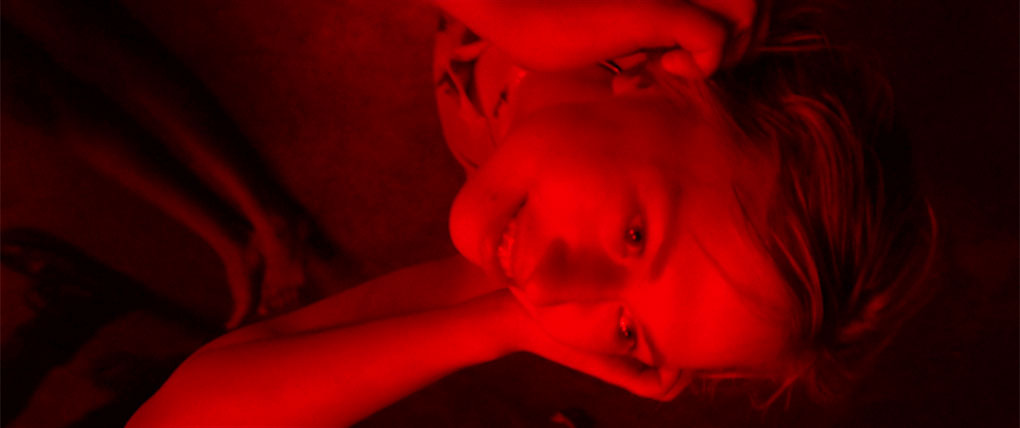
Shaman of the Screen: The Films of Gaspar Noé (29:23)
A fascinating new video essay by writer Alexandra Heller-Nicholas that takes us on a detailed trip through Gaspar Noé's film career using extracts from his features, his short films and his music videos. It's as comprehensive an introduction to Noé's work as you could ask for, though be aware that this where the disc really earns its 18 certificate. If you're familiar with Noé's work, you'll doubtless have guessed why.
Shoot Short Film (3:14)
Directed by Noé as part of Short Plays, a 2014 omnibus from Mexican filmmaker Daniel Gruener that brought together 32 short films by celebrated filmmakers from around the world, all of them inspired by football. Noé's segment finds him in playfully experimental mode, as a kick-about on an Argentinean building site is filmed in slow motion and entirely from the viewpoint of the tumbling ball. It's surprisingly intoxicating, though I'd imagine it could be a little stomach-churning on a big screen.
Music Videos
SebastiAn: Love in Motion(3:59)
Directed by Noé in 2012 and featuring actress LenteTresnor, this video features a young girl miming to the title track as if shot on a camcorder by her similarly aged brother, though without that overly familiar camcorder video aesthetic. It's bright and colourful, but I know I'm not the only one who finds the image of a pre-pubescent girl dancing provocatively a little creepy, irrespective of the innocence of the intention.
Thomas Bangalter: Sangria (3:18)
The music video for one of two tracks by Bangalter – who also provided the score for Noé's Irréversible – that appear in the film is constructed from extracts from it, primarily top shots of the mid-film dance sequence where the drugged dancers compete against each other, shots whose colour filtration changes to the beat and builds to a fit-inducing frenzy. You have been warned.
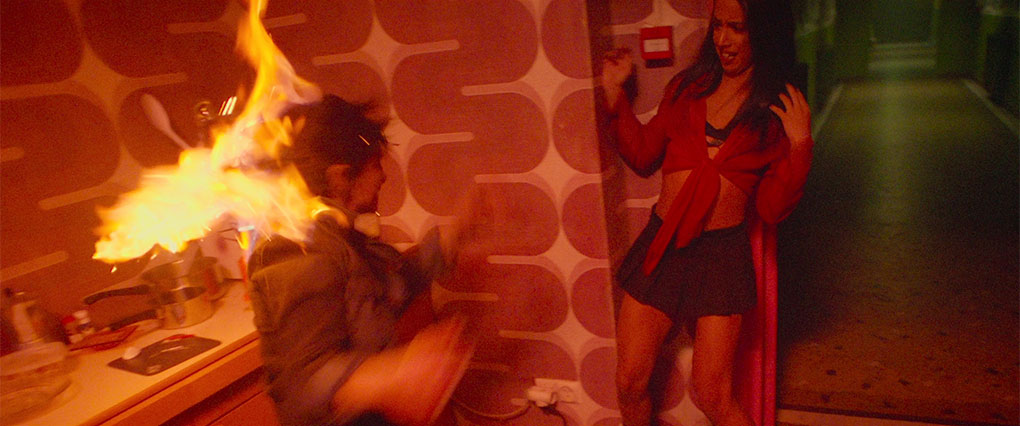
Theatrical Trailer (1:00)
An intriguing trailer build around the opening dance track with glittered words cut with short extracts that only give a suggestion of the descent into madness that the story later takes. Conceptually, it plays like a less sensory-assaulting take on Stanley Kubrick's extraordinary trailer for A Clockwork Orange.
Also included with the first pressing only of the release disc is a Collector's Booklet featuring new writing on the film by Anton Bitel alongside the original press kit, but this was not available for review.
I've read claims that Climax is Gaspar Noé's best film since Irréversible, and despite the very high opinion in which I hold Enter the Void, it's hard not to agree. It's got an absolute belter of an opening hook, a brilliant soundtrack, and rarely has the concept of letting the performers help create their characters and improvise their dialogue paid such rewarding dividends. I may not be comfortable with the places Noé takes me, but I always get so much from the journey and this is already my most watched Noé film, and the opening dance my most viewed sequence of the year so far. Arrow's Blu-ray delivers on the transfer, but really scores in the special features, all of which have been assembled with care and added to my enjoyment of the film or my appreciation of Noé as a filmmaker. Highly recommended.
|